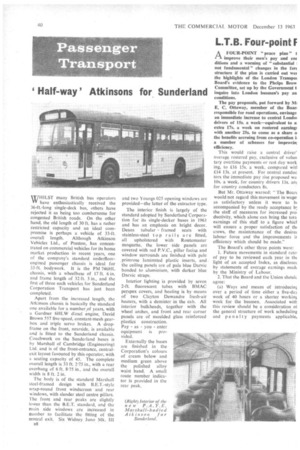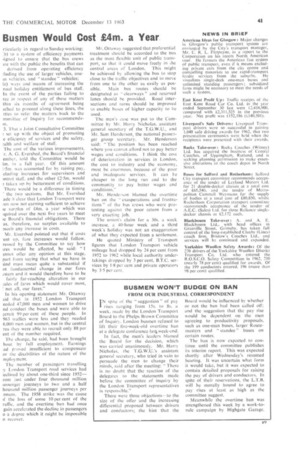L.T.B. Four-point F Busmen Would Cost Um. a Year Half-way ' Atkinsons for Sunderland
Page 42

Page 43

If you've noticed an error in this article please click here to report it so we can fix it.
WHILST many British bus operators VI' have enthusiastically received the 36-ft.-long single-deck bus, others have rejected it as being too cumbersome for congested British roads. On the other hand, the old length of 30 ft. has a rather restricted capacity and an ideal compromise is perhaps a vehicle of 33-ft. overall length. Although Atkinson Vehicles Ltd., of Preston, has concentrated on commercial vehicles for its home market production in recent years, one of the company's standard underfloorengincd passenger chassis is ideal for 33-ft. bodywork. It is the PM 7461-IL chassis, with a wheelbase of 17 ft. 6 in. and frame length of 32 ft. 3 in., and the first of three such vehicles for Sunderland Corporation Transport has just been completed.
Apart from the increased length, the Atkinson chassis is basically the standard one available for a number of years, with a Gardner 6HLW diesel engine, David Brown 557 five-speed, constant-mesh gearbox and triple servo brakes. A dropframe on the front, nearside, is available and is fitted to the Sunderland chassis. Coachwork on the Sunderland buses is by Marshall of Cambridge (Engineering) Ltd. and is of the front-entrance, centralexit layout favoured by this operator, with a seating capacity of 45. The complete overall length is 33 ft. 2-75 in., with a rear overhang of 6 ft. 8.75 in., and the overall width is 8 ft. 2 in.
The body is of the standard Marshall steel-framed design with B.E.T.-style wrap-round front windscreen and rear windows, with slender steel centre pillars. the front and rear peaks are slightly lower than the B.E.T. standard, and the main side windows are increased in number to facilitate the fitting of the central exit. Six Widney Juno. Mk. III
and two Youngs 025 opening windows are provided—the latter of the extractor type.
The interior finish is largely of the standard adopted by Sunderland Corporation for its single-decker buses in 1961 and has an emphasis on bright decor. Deans tubular framed seats with stainless-steel top rails are fitted, all upholstered with Routernaster moquette, the lower side panels are covered with red P.V.C., pillar facias and window surrounds are finished with pale .primrose laminated plastic inserts, and. the ceiling panels are of pale blue Darvic bonded to aluminium, with darker 'blue Darvic straps.
Interior lighting is provided by seven 2-ft. fluorescent tubes with BMAC perspex covers, and heating is by means of two Clayton Dewandre fresh-air heaters, with a demister in the cab. All interior bulkheads, together with the wheel arches and front and rear corner panels are of moulded glass reinforced plastics construction. Pay as you enter equipment is provided.
Externally the buses are finished in the Corporation's colours of cream below and medium green above the polished alloy waist band. A small route number indicator is provided in the rear peak,
A FOUR-POINT "peace plan" 1-1 improve their men's pay and cot ditions and a warning of "substantial not fundamental changes in the fart structure if the plan is carried out WCI the highlights of the London Transpoi Board's evidence to the Phelps Brow Committee, set up by the Government t inquire into London busmen's pay an conditions.
The pay proposals, put forward by IN1 E. C. Ottaway, member of the Roan responsible for road operations, envisage an immediate increase to central Lando] drivers of 15s. a week—equivalent to a. extra 17s. a week on rostered earnings with another 25s. to come as a share o the benefits accruing from co-operation ii a number of schemes for improvin efficiency.
This would raise a central driver' average rostered pay, exclusive of volun tary overtime payments or rest day work ing, to £16 15s. a week. compared witl
14 13s. at present. For central conduc tors the immediate pay rise proposed wa 10s. a week, for country drivers lls. am for country conductors 8s.
But Mr. Ottaway warned: "The Boar( would not regard this movement in wage! as satisfactory unless it were to hi accompanied by the ready acceptance b: the staff of measures for increased pro ductivity, which alone can bring the Iota earnings of this staff to a figure whicl will ensure a proper satisfaction of thi crews, the maintenance of the desire( labour force and the improvements it efficiency which should be made."
The Board's other three points were:
1. Future movements in standard rate, of pay to be reviewed each year in th( light of an accepted Index, as disclose( by statements of average earnings math by the Ministry of Labour.
2. That the Board and the Union shciuk agree:
(a) Ways and means of introducint over a period of time either a five-day week of 40 hours or a shorter workinE week for the busmen. Associated with this review should be a consideration oi the general structure of work scheduling and penalty payments applicable,
rticularly in regard to Sunday working; :b) to a system of efficiency payments ;igned to ensure that the bus crews are with the public the benefits that can derived from operating efficiency :hiding the use of larger vehicles, onein vehicles, and standee" vehicles; (c) ways and means of increasing the nual holiday entitlement of bus staff, In the event of the parties failing to ree in respect of any of these matters thin six months of agreement being iched to proceed along these lines, the rties to refer the matters back to the )mmittee el' Inquiry for recommentiaon.
3. That a Joint Consultative Committee set up with the object of promoting e efficiency of services and the safety, :alth and welfare of staff, The cost of the various improvements, .r. A. G. ENershed, the Board's financial ember, told the Committee would be fin. in a full year. Of this amount L.5m. was accounted for by raising pay, eluding increases for supervisors and intro) staff, and the other £2-5m. would ; taken up by betterment of conditions. There would be a difference in timing ' the two sections. But Mr. Evershed ade ii clear that London Transport were /en now not earning sufficient to achieve Le surplus of £4m. a year which was ;quired over the next five years to meet re Board's financial obligations. There as, therefore, no surplus available to )sorb any increase in costs.
Mr. Evershed pointed out that if costs 'ent up, fare increases would follow.
ressed by the Committee to say how tres would be affected, he said: " I Innot offer any opinion at this stage, part from saying that what we have in rind must mean quite a substantial if ot fundamental change in our fares /stem and it would therefore have to be fairly far-reaching alteration in our :ales of fares which would cover most, ! not all, our fares."
In his opening statement Mr. Ottaway aid that in 1952 London Transport ceded 47,000 men and women to drive nd conduct the buses and were able to ,cruit 99 per cent of these people. In 963 traffics were less and they needed 6,000 men and women, but in the central rea they were able to recruit only 88 per ent of the number required.
The change, he said, had been brought bout by full employment. Earnings ad proved insufficient to compensate or the disabilities of the nature of the mploymen t.
The number • of passengers travelling ,y London Transport road services had
teclined by about one-third since 1952— rom just under four thousand million ■ assenger journeys to two and a half housand million passenger journeys per
nnum. The 1958 strike was the cause of the loss of some 10 per cent of the
raffle, and the overtime ban had once gain accelerated the decline in passengers o a degree which it might be impossible o recover. Mr. Otiaway suggested that preferential treatment should be accorded to the bus as the most flexible unit of public transport, so that it could move freely in the central areas of London. This might be achieved by allowing the bus to stop close to the traffic objectives and to move from one to the other as easily as possible. Main bus routes should be designated as " clearways" and reserved lanes should he provided. Road intersections and turns should be improved to enable buses of higher capacity to be used.
The men's ease was put to the Committee by Mr. Harry Nicholas, assistant general secretary of the T.O.W.U., and Mr. Sam Henderson, the national passenger group secretary. Mr. Henderson said: " The position has been reached where you cannot afford not to pay better wages and conditions. I think the cost of deterioration in services in London, the cost to industry and the economy, must be enormous, because of the poor and inadequate services. It can be cheaper in the long run and to the community to pay better wages and conditions."
Mr. Henderson blamed the overtime ban on the " exasperations and frustrations" of the bus crews who were protesting against the poor return from a very exacting job.
The union's claim for a 30s. a week increase, a 40-hour week and a third week's holiday was not an exaggeration of what they expected from a settlement.
He quoted Ministry of Transport figures that London Transport vehicle mileage had dropped by 24 per cent from 1952 to 1962 while local authority undertakings dropped by 3 per cent, B.T.C. services by 1-8 per cent and private operators by 3-5 per cent.




















































































































